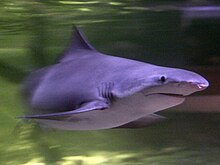
Back جليفيس جليفيس ARZ Glyphis glyphis Catalan Glyphis glyphis CEB Speerzahnhai German Glyphis glyphis Spanish Glyphis glyphis Basque کوسه دنداننیزهای Persian Glyphis glyphis French כריש שן-חנית HE Speertandhaai Dutch
| Speartooth shark | |
|---|---|

| |
| Scientific classification | |
| Domain: | Eukaryota |
| Kingdom: | Animalia |
| Phylum: | Chordata |
| Class: | Chondrichthyes |
| Subclass: | Elasmobranchii |
| Subdivision: | Selachimorpha |
| Order: | Carcharhiniformes |
| Family: | Carcharhinidae |
| Genus: | Glyphis |
| Species: | G. glyphis
|
| Binomial name | |
| Glyphis glyphis (J. P. Müller & Henle, 1839)
| |

| |
| Range of the speartooth shark | |
The speartooth shark (Glyphis glyphis) is a rare species of river shark, belonging to the family Carcharhinidae. It inhabits coastal marine waters and tidal reaches of large tropical rivers in northern Australia and New Guinea. Despite being a member of the river shark genus, it is also found in near-shore marine waters, favoring highly turbid environments over a wide range of salinities. This robustly built, gray-colored shark is characterized by a short and broad snout, tiny eyes, a relatively large second dorsal fin, and a black blotch beneath each pectoral fin near the tip. Another identifying trait is its teeth, which are large, triangular, and serrated in the upper jaw and narrow, spear-like, and serrated only near the tips in the lower jaw. Adults grow to about 2.6 m (8.5 ft) long.
Preying on demersal bony fishes and crustaceans, the speartooth shark is adapted for hunting in near-complete darkness. It is not as active as other requiem sharks, moving upstream and downstream with tidal currents so as to save energy. Reproduction is viviparous, with females forming a placental connection to their young, though details are unknown. The speartooth shark is threatened by incidental capture in commercial and recreational fisheries, as well as by habitat degradation. Given its small population, restricted range, and stringent habitat requirements, this species is highly susceptible to these pressures and has been listed as vulnerable by the International Union for Conservation of Nature.
- ^ Kyne, P.M.; Rigby, C.L.; Darwall, W.R.T.; Grant, I.; Simpfendorfer, C. (2021). "Glyphis glyphis". IUCN Red List of Threatened Species. 2021: e.T39379A68624306. doi:10.2305/IUCN.UK.2021-2.RLTS.T39379A68624306.en. Retrieved 19 November 2021.
© MMXXIII Rich X Search. We shall prevail. All rights reserved. Rich X Search
